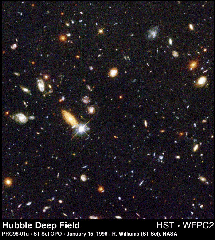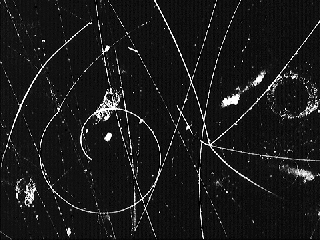Updated: 31 October 2006
Scale Relativity


these HTML pages are devoted to
the concepts of Scale Relativity and Fractal Space-Time. For more detail,
refer either to the book (Fractal Space-Time
and Microphysics, World Scientific, 1993), or to a more recent (1996) review
paper, or the popular books (in french) "La
relativité dans tous ses états" (Hachette, 1998, Paris,
319 pp.) and "Les arbres de l'évolution"
(L.
Nottale, J. Chaline et P. Grou, Hachette Littératures, 2000). More
generally, consult the bibliography published
on the subject, the list of downloadable papers,
or the author at the following e-mail address: laurent.nottale@obspm.fr.
These pages have been developped from a first version achieved by E.
Lefèvre.
The author:
This theory is proposed by Laurent Nottale,
researcher at Paris-Meudon
Observatory. He worked for a long time in parallel on cosmology and
gravitational
lenses, (see his book in French "l'Univers
et la Lumière", Flammarion, Nouvelle Bibliothèque Scientifique
1994, Champs 1998, Prix du livre d'Astronomie Haute-Maurienne-Vanoise 1995).
But he is now devoting most of his activity to the development of the theory
of Scale Relativity (in french: Relativité d'Echelle) within
LUTH
department.
In this chapter, we first present the origin
of the Scale Relativity (or ScR) theory: we will briefly evoke the reasons
that led to its development.
The fundamental principle
of ScR:
It is an extension of the principle of relativity. It can be stated as
follows: The laws of nature must be valid in every coordinate systems,
whatever their state of motion and of scale. The results obtained
show once again the extraordinary efficiency of this principle at constraining
and/or at constructing the laws of physics.
The formalism developed for ScR is already sufficiently settled to be used
"as is" to deal with a particular problem in many situations. The procedure
is outlined in this chapter. The most general version of the theory is
still under construction.
The formalism and its consequences:
-
The resolution become explicit variables, which play for
scale transformations the role played by the velocity for motion laws.
They are considered as defining the state of scale of the reference system,
in similarity with the velocity defining its state of motion. Like velocity,
they can be defined only in a relative way: only scale ratios do have a
physical meaning, never an absolute scale.
-
The principle of relativity, that had up to now been applied to
changes of position (Giordano Bruno), of orientation and
of small inertial motions (Galileo, Huygens), then of any inertial
motion (special motion relativity: Poincaré, Einstein), and
finally to accelerated motion and gravitation (general relativity
of motion: Einstein), is extended to scale transformations (on resolutions).
-
The principle of covariance implements the principle of relativity
at the level of the equations of physics. Their scale covariance means
that they should keep their (simplest) form in scale transformations of
the coordinate system. Weak covariance means that the equations
of physics keep, in a general transformation, the same simple form as in
a previous special case (example: Einstein's gravitational field equations
have a form similar to the Poisson equation of Newtonian gravitation theory,
still including a source term). Strong covariance means that the simplest
possible form of the equations has been obtained, namely, that of the vacuum
devoid of any force (this is the case of the equation of dynamics in Einstein's
general relativity of motion, written as a geodesics equation).
-
The principle of equivalence specifies the expression of the principle
of relativity-covariance for a given physical "object". Hence, in the case
of Einstein's principle of equivalence for gravitation, "a gravitational
field is locally equivalent to an acceleration field". Gravitation can
be locally suppressed by the choice of an accelerated coordinate system,
and therefore does not exist in itself. It exists only in a way relative
to the reference system.
-
The geometry of Space-Time
is generalized by keeping the hypothesis of its continuity, but
giving up the hypothesis of its differentability. Recall that Riemannian
manifolds, on which Einstein's general relativity is founded, are at least
of class C2, i.e., they are two times differentiable, except possibly at
some singularities. On the contrary, in the theory of scale relativity
one considers spaces that are everywhere or almost everywhere non-differentiable.
Then one proves the theorem, according to which a continuous and nondifferentiable
space is fractal.
-
Scale covariance is achieved by the introduction of covariant
derivatives, that are built following an approach analog to the construction
of the covariant derivative in general relativity. Namely, in the same
way as the GR covariant derivative takes into account the geometric effects
of the curvature of space-time, these new derivation operators take into
account the new properties of nondifferentiability and of fractality of
the space-time geometry.
-
One therefore defines a new total derivative (accounting for the effects
of nondifferentiability), the quantum-covariant
derivative, that allows one to write under a same form the equations
of classical and quantum mechanics. Hence the fundamental equation of dynamics,
made covariant by the use of this ovariant derivative, takes the form of
a geodesics equation. It can be subsequently integrated under
the form of the Schrödinger equation (for any number of dimensions),
of the Klein-Gordon equation in the relativistic case, and of the
Pauli
and Dirac equation in the more general case that includes spin (itself
built by the theory). These results are valid as well for one particle
as for many (in particular undiscernable) particles.
-
A scale covariant derivative takes into account the effects of variation
of the fractality (under which the internal resolutions become themselves
variables in function of space and time). This involves the appearance
of gauge fields, Abelian (such as electromagnetism) and non-Abelian (such
as the weak and strong field) as manifestations of the fractal geometry
of space-time.
Some consequences:
-
Existence of two asymptotic, unexceedable and invariant
under dilation scales : lP: Planck
length (minimal scale) and L: cosmological
length (maximal scale), in the framework of new "Lorentzian" scale
laws.
-
Natural apparition of structures in some systems because of the
theory
itself: spontaneous self-organization.
-
Organization in chaotic systems (at very large time
scales relative to the chaos time).
-
Formally macroscopic quantum-like description (not based on Planck
constant, but on a macroscopic constant that is specific of the system
under consideration) of some chaotic systems beyond their
predictability
horizon (t >>20 t_chaos)
(Summary)
The classification is only indicative since some problems belong to
several categories. It is however not an arbitrary one because the 3 fields
of microphysics, cosmology and chaotic systems
correspond
to privileged fields of application of ScR. Respectively:
dx et
dt
tending towards zero, dx tending towards infinity and
dt tending
towards infinity. These are the three frontiers of today's physics: the
infinitely small, the infinitely large and the infinity of complexity.
-
Particle physics: --> see review paper (1996)
"Scale
Relativity and Fractal Space-Time: Application to Quantum Physics..."
-
Cosmology: ---> review paper
on this subject (2003): "Scale-relativistic
cosmology" (PDF)
-
solution to the problem of horizon/causality without inflation.
-
large scale structures of the Universe: fractal dimension of the distribution
of galaxies.
-
prediction of the value and meaning of the cosmological constant.
-
solution to the problem of vacuum energy density.
-
explanation for Dirac's large numbers coincidence and achievement of Mach's
principle.
-
Chaotic systems
---> review paper on this subject (2003): "Gravitational
structure formation in scale relativity" (PDF)
-
morphogenesis of gravitational systems.
-
prediction of the distributions of the distances, eccentricities and masses
of the planets in the Solar System
-
verification in extra-solar planetary systems
(see catalog of exoplanets).
-
quantification of velocity differences in binary galaxies.
-
other quantification effects: stellar radii, obliquities and inclinations
in the solar system, giant planet satellites, asteroids distribution, binary
stars, star formation regions, galactic structures, local group of galaxies,
compact groups, clusters and superclusters of galaxies, large scale structures...
As predicted by the theory, the structures observed at all scales come
under a unique fundamental constant having the dimension of a velocity
-
Sciences of life:
For a more complete list of the results and predictions of the scale-relativity
theory, see Sec. 9 of the review paper: "Scale
Relativity and Fractal Space-Time". A html completed version of this
section can be found here.
Non exhaustive bibliography,
author's list of publication (all subjects),
list of publication of the author and others
on scale relativity
Some definitions of the terms used (links in italic).
Other sites:
Some of the precursors: Galileo,
Newton,
etc.
Developed from an initial version due to Eric
Lefèvre. To contact him click here
ou there



